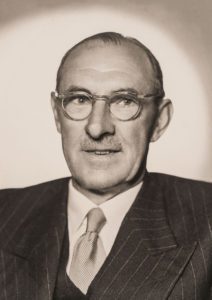 |
|
Sir Norman Gregg. From “Rashes to Research: Scientists and Parents Confront the 1964 Rubella Epidemic.” Royal Prince Alfred Hospital Museum and Archives via US National Library of Medicine. Fair use. |
Sir Norman Gregg was an Australian eye doctor who in 1941 noticed that some mothers suffering from rubella during pregnancy had babies with severe eye abnormalities.
Born in 1892 in Burwood, a suburb of Sydney, Gregg studied medicine at the University of Sydney, played cricket and tennis for the state of New South Wales, and fought in France during World War One. In the 1930s he developed an interest in ophthalmology and pursued further training in England. Returning to Sydney, he set up a practice and also joined the staff of the Royal Prince Alfred Hospital as a pediatric ophthalmologist. While working at that hospital, he noticed during a rubella outbreak that several newborn babies born to mothers who had had the disease during pregnancy developed severe eye abnormalities. This was the first time that a link between rubella and birth defects had been identified.
Following this observation, Gregg carried out a detailed analysis of over 1,000 pregnant women who had been infected with rubella. He found the risk of birth defects was much greater for women who had contracted the disease during the first trimester of pregnancy and that defects were more severe the earlier in the pregnancy the infection occurred.
As a result of his research it became clear that rubella could have devastating effects on unborn babies. This observation led to the development in 1969 of a vaccine that dramatically reduced the incidence of rubella and its complications.
Gregg also made other important contributions. He developed new techniques for treating cataracts and studied the effects of radiation on the eyes to establish safe levels of exposure for medical professionals and patients. He received many distinctions, medals, and honorary degrees, was knighted, and became a member of the Order of Australia. He died in 1966 and is remembered as a man who saved many lives through his observation.
GEORGE DUNEA, MD, Editor-in-Chief
Winter 2023 | Sections | Physicians of Note

Leave a Reply